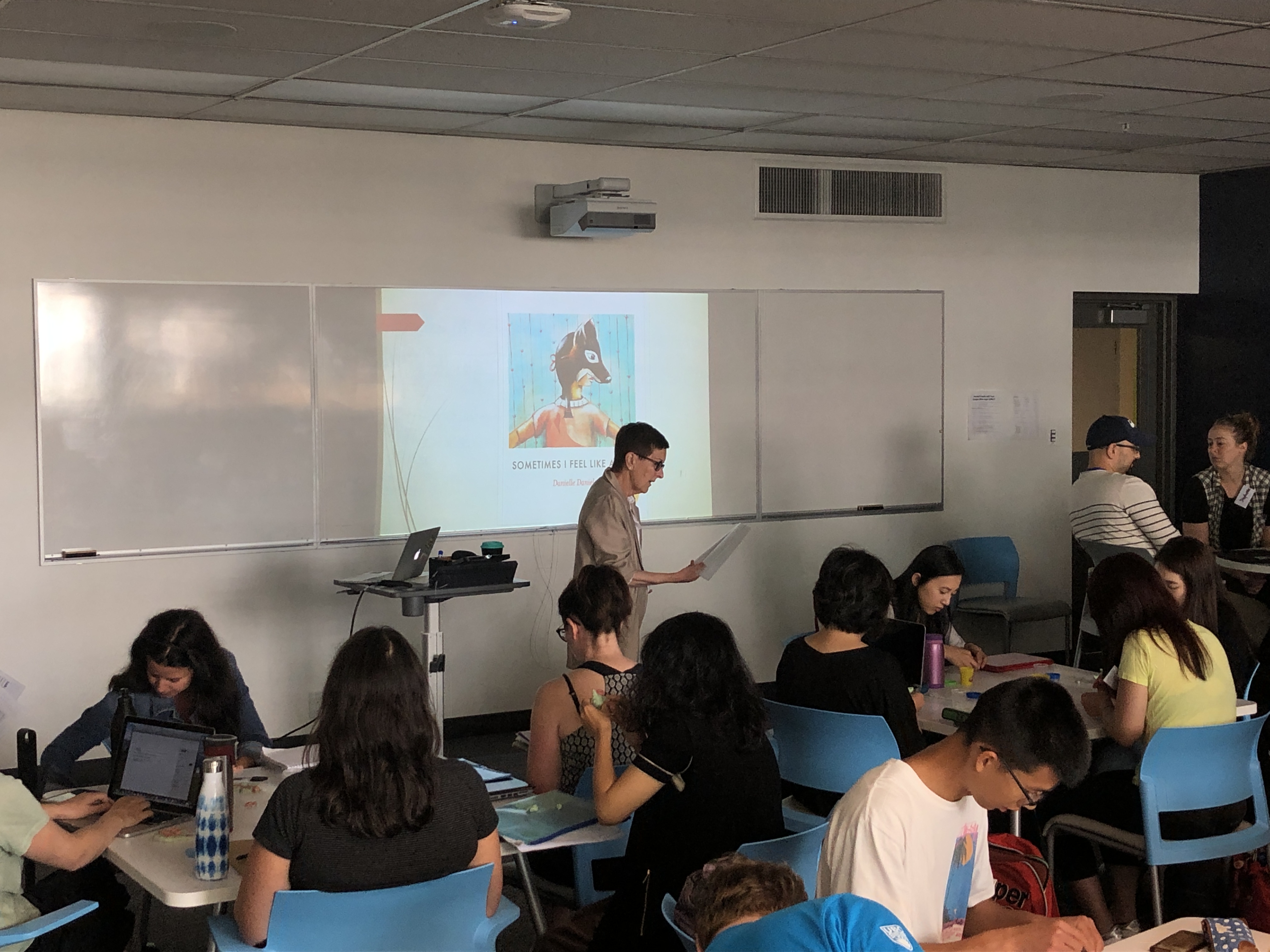“Play is nature’s way of teaching children how to solve their own problems, control their impulses, modulate their emotions, see from others’ perspectives, negotiate differences, and get along with others as equals. There is no substitute for play as a means of learning these skills.” (Gray, 2013)
Through play, children of all ages, including adolescents, learn to make sense of the world around them. While there are many forms of play in learning, free play provides rich opportunities for children to make decisions for themselves and to learn from their errors. As teachers, we can and should incorporate various forms of active play into our learning environments.

I always enjoy opportunities to engage in playtime with teacher candidates and instructors in the BEd Program. Below are two examples of that play (including how we infused play yet still structured our lessons). In September 2019, working with Dr. Margot Filipenko and the TELL3C (Teaching English Language Learners through cross-curricular case-based inquiry) and a play-based stations approach and in September 2023, once again working with TELL3C but taking a more ‘whole class’ approach scaffolding play with playdough to, eventually, help students build understandings of conductivity.
September 2019
Our play included digital and non-digital or, as I like to say, “plugged” and “unplugged” opportunities and went from teacher-led or initiated to more free-play. We began with a provocation and some time with a lump of playdough before reading Sometimes I feel like a Fox by Danielle Daniel.
Taking a hands-on stations-based approach can help promote a play-oriented learning environment in which students are actively engaged in ‘hands-on, minds-on’ learning. By setting up stations, we can scaffold learning to help all students find success. Often, we think only of young children when we consider stations or centers and playtime. We need, however, to consider learners at all stages of development. Play-based learning through stations can support peer-to-peer learning – particularly important in adolescence. In addition, stations and other play periods allow teachers to support student inquiry through prompting, probing and providing key vocabulary ‘just in time’ for learning. For a little more on pedagogies of play, see our session slides.Let’s Play_ Technology Inquiry and Play_Sept 2019
Stations we set up for our workshop
- Scratch Jr Coding app (free iOs and Android app)
- Ozobot robots: coding can be kinesthetic (kit available in the UBC Ed Library Scarfe 155)
- Magnet play (kit available in the UBC Ed Library Scarfe 155)
- Puppets (a selection available for loan in the UBC Ed Library Scarfe 155)
- Squishy Circuits (kit available in the UBC Ed Library Scarfe 155)
- Loose Parts (various odds & ends & manipulatives I’ve gathered for story-making and interdisciplinary STEAM learning – I’m always happy to loan to TCs!)
- rocks, minerals and fossils with sorting prompt cards
- shells, marine artifacts, field guides & magnifiers
- various small toys and figures for stop motion stories
- Augmented Reality Dinosaur cards (I have Dinosaur 4D), plastic dino figures & book
- I’ve also used Animal 4D cards with plastic animal figures and a book
September 2023
Rather than a stations-based approach, this time we modelled scaffolding learning through some whole-class play. Again students began with a lump of playdough…
Progression
- Playing and Modelling with dough (free play with determined materials)
- Responding to a prompt by remaking or modelling something the prompt inspired (a more guided play)
- Observing materials with our senses: What are the properties of the dough? What do we notice? What can we learn?
- Learning about conductive and non-conductive materials – we used the playdough and other materials (both conductive and non-conductive) to play some digital drums or piano using Makey Makey connected to a laptop (an interesting little micro-controller that connects by USB to your device and can be used to basically mimic/take over for your keyboard.
- NB: taking a PEOE (predict, explain, observe, explain) approach, students could sort and classify materials, look for other materials around the classroom or outdoors, etc.
- Using what we learned about conductivity to create a simple circuit using ‘Squishy Circuits’ (our playdough along with some alligator clips, LED lights and batteries). Squishy Circuits was developed by U of St. Thomas and is a wonderful, experiential way to help children be creative and explore circuitry. For a bit more on circuitry, including moving from Squishy Circuits to Paper Circuits projects, visit Making Connections: playing with electrical circuits.
Playing to learn a digital tool
In the BC Digital Literacy Framework, there is a clear expectation that digital technologies are effectively integrated into the classroom to support student learning and in the International Baccalaureate Program’s IB PYP document, “The Learning Community”, technology integration is seen as a 3-part interconnected model: Learning about, Learning with and Learning through digital technologies. I see these two documents as mutually supportive of play.
In these play-based learning sessions, we modelled how TCs might integrate play in the classroom and considered Bird and Edwards (2015) as we planned:
…students begin engaging with the object/device—digital or non-digital—with exploration in mind to investigate, learn and test their theories about Technology…
By allowing students time to explore any technology (be it a digital or analogue tool such as a math manipulative), we engage their naturally curious brains, allowing them to ‘play out’ the technology. Doing so can lead to more purposeful use, peer teaching and even student-driven innovation.
Members of the learning community actively choose and use multiple technologies in the classroom. This supports a key aspect of technology literacy: the capability to discern appropriate technologies based on the desired outcomes of the learning activity or inquiry (Davies, 2011 in The Learning Community p. 49).
in 2019, students played with ‘StoryBird‘ – a very visual and artistic little browser-based app for digital storytelling. Within 15 minutes, the students were able to effectively utilize the app to begin creating stories and poems. We learned that we can also find and read stories shared in the storybook community. (NOTE: at some point following our session, the Storybird licensing structure changed; limiting free access to creating stories)
- Storybird allows students to begin with picture prompts – keep in mind that it is best for students who can read and write. For students who can not yet access text, there are more multimodal options including Digital Whiteboard applications. Without using Storybird, A teacher might also print or project images as prompts to inspire creative expression. You may find this blog post about digital storytelling of interest.
In 2023, we played with ShowMe, a free digital whiteboard that allows users to voice/audio narrate, add images, video, and annotate by drawing or adding text. Students can literally ‘show’ what they know about a topic or tell a story in their own ways using their own voices. We could have used any of the digital whiteboard apps available – all with slightly different features. See this blog post for a few more options. Most school ipads will have at least one digital whiteboard app available.
Something I hope I was able to convey through modelling is an approach to introducing ‘new’ digital technologies to students experientially and playfully. Rather than ‘teaching’ the whole class ‘how to’ use a particular technology (and risk losing many of your students to boredom or going over their heads), I learned to provide my students (of ALL ages from K through secondary) opportunities to play with a given app or tool for some time before there is an expectation of actually using it for a given purpose. I find this helps lessen anxiety and allows students to learn from and teach one another. Here is a detailed lesson plan based on the KDU (Know, Do, Understand) model for how I ‘taught’ Storybird. My ‘general’ process for this:
- Show the students a very brief example of the technology ‘in action’
- Provide time for the students to play with the technology in pairs or small groups (with the instruction that they may only ask the teacher to help with tech issues – can’t open, won’t boot, etc – for the first 5 to 15 min depending on the complexity of the tech).
- The teacher circulates and invites students to share (or ‘satellite’) their knowledge with others.
- Once students have had exposure to different ways of representing their learning, I strongly recommend providing them with some choice and agency. Providing the choice of medium, from digital to analogue, helps meet the needs of varied learners and supports a Universal Design for Learning approach to planning and teaching.
- Remember to honour the creative process by allowing time for students to share what they made!
In my experience, students can and will teach themselves and each other even more complex applications. I followed the above process with a group of grade 1/2 students using Garage Band to learn to create PodCasts. Within about 1/2 hour, all of the students were able to create a file, add loops, add audio and images. After their initial exploration, students storyboarded and created some very informative podcasts about the salmon in our classroom and were ready to share with the school!
As a long time elementary teacher, I try to provide my students with time to ‘play out’ and experiment with any technology – from math manipulative to science equipment to art supplies to digital technologies. Philosophically, I love being able to incorporate the above approach into my co-teaching in the BEd program and hope TCs are reminded to give their own students such opportunities in order to allow them time to co-construct their knowledge and skills (and develop positive attitudes towards technologies and learning!) YD
References:
Bird, J. and Edwards, S. (2015), Children learning to use technologies through play. Br J Educ Technol, 46: 1149-1160. doi:10.1111/bjet.12191
Gray, Peter. Free to Learn : Why Unleashing the Instinct to Play Will Make Our Children Happier, More Self-Reliant, and Better Students for Life, Basic Books, 2013. ProQuest Ebook Central, https://ebookcentral.proquest.com/lib/ubc/detail.action?docID=1113872.

